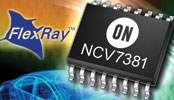FlexRay transceiver
17 October 2012
Telecoms, Datacoms, Wireless, IoT

ON Semiconductor has expanded its portfolio of automotive networking products with the introduction of a bus transceiver IC that is compliant with the most recent adaptation to the FlexRay communications protocol.
The NCV7381 is a highly robust, single-channel device capable of data transfer speeds up to 10 Mbps. Conforming fully with FlexRay Electrical Physical Layer Specification Rev. 3.0.1, the new device offers a differential transmit and receive capability between the wired FlexRay communication medium and the protocol controller/host.
The IC’s mode control functionality is optimised for nodes permanently connected to car batteries. The device offers low-power operation and a low power mode receiver that allows remote wake-up detection.
Capable of running from a 5,5 V to 50 V battery supply, the NCV7381 can be integrated into both 12 V and 24 V automotive power systems. It has strong electromagnetic susceptibility (EMS) performance across its full frequency range.
The device has a high degree of electrostatic discharge protection and is able to cope with in excess of 10 kV ESD pulses. It is AEC qualified and has an operational temperature range of -40°C to +125°C.
Further reading:
The trends driving uptake of IoT Platform as a Service
Trinity IoT
Editor's Choice Telecoms, Datacoms, Wireless, IoT
IoT platforms, delivered as a service, are the key that will enable enterprises to leverage a number of growing trends within the IT space, and access a range of benefits that will help them grow their businesses.
Read more...
RF power amplifier
RF Design
Telecoms, Datacoms, Wireless, IoT
The ZHL-20M2G7025X+ from Mini-Circuits is a 32 W power amplifier that operates from 20 to 2700 MHz and delivers a saturated output power of +45 dBm.
Read more...
Introducing the Quectel EG800Z series
iCorp Technologies
Telecoms, Datacoms, Wireless, IoT
The EG800Z series is Quectel’s latest ultra-compact LTE Cat 1 bis module, designed to deliver reliable connectivity, low power consumption, and robust performance across a wide range of IoT applications.
Read more...
NeoMesh on LoRa
CST Electronics
Telecoms, Datacoms, Wireless, IoT
Thomas Steen Halkier, CEO of NeoCortec, recently gave a keynote speech where he spoke about “NeoMesh on LoRa: Bringing true mesh networking to the LoRa PHY”.
Read more...
Modules upgraded with Direct-to-Cell tech
iCorp Technologies
Telecoms, Datacoms, Wireless, IoT
Quectel Wireless Solutions has announced that several of its LTE modules are now available with Direct-to-Cell (D2C) functionality, enabling devices to seamlessly connect to satellite networks.
Read more...
USB/Ethernet smart RF power sensor
RF Design
Telecoms, Datacoms, Wireless, IoT
The PWR-18PWHS-RC from Mini-Circuits is an RF power sensor that operates from 50 MHz to 18 GHz and is designed to capture pulsed and trace modulated signals with very high data resolution.
Read more...
Tiny Bluetooth LE + 802.15 + NFC module
RF Design
Telecoms, Datacoms, Wireless, IoT
Unleashing enhanced processing power, expanded memory, and innovative peripherals, the BL54L15µ from Ezurio is the ultimate choice for small and low power connectivity.
Read more...
AI modules for edge intelligence
Otto Wireless Solutions
Telecoms, Datacoms, Wireless, IoT
SIMCom has introduced two new entry-level AI computing modules, the SIM8668 and SIM8666, designed to bring intelligent capabilities to lightweight, energy-efficient edge devices.
Read more...
High performance ISM antennas
iCorp Technologies
Telecoms, Datacoms, Wireless, IoT
Quectel Wireless Solutions has announced the launch of two new high performance ISM antennas, designed to meet the need for wireless communication in devices that operate in the industrial and commercial applications.
Read more...
Quad-band high-precision positioning module
iCorp Technologies
Telecoms, Datacoms, Wireless, IoT
Quectel Wireless Solutions has recently announced the launch of the LG680P, a multi-constellation, quad-band GNSS module designed to deliver high-precision positioning across a wide range of applications.
Read more...


